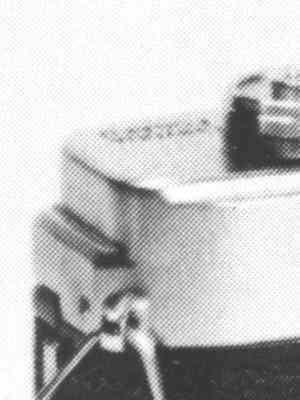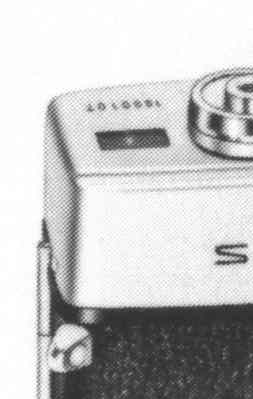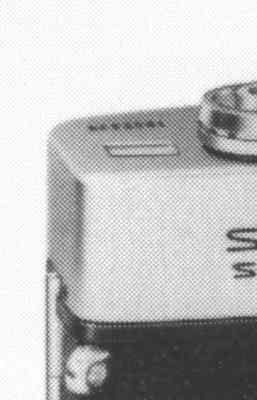
MINOLTA 35mm SLR CAMERA COMPARISON
When we think of a camera model we normally assume that all of the cameras
in that model line were exactly the same. But just as camera models
evolved over time, for example, from the SRT100 to the SRT200, there are
differences between models in the same line. For example, most SRT101
cameras have a mirror lockup switch. This feature was dropped from
the SRT101 line toward the end of the run. This table breaks these
versions of the same camera as (model a, model b, etc). These model
designations are not inscribed on the camera and are merely our particular
way of labeling different cameras. Other websites will use their own
breakdowns that will differ from those you see here.
Another type of change in the cameras is the body styling. The camera
in a particular model line may have the same features, but vary in body styling.
For example, the SRT series had three body styles:



The original style (TYPE A) was used in 1958 on the SR2 and had a ridge on
the front and side of the camera. The second style (TYPE B) appeared
in 1965 on the SR1 and just had the ridge on the front of the camera. The
third style (TYPE C) appeared in 1973 on the SRT102 and did not have either
ridge. Since, for example, the SRT102 series initially used TYPE C
bodies, you might expect that all SRT200 series cameras would only use TYPE
C bodies since they appeared after the SRT102. Not so. The SRT 200
& 201 series used the TYPE B body. And the SR3 of 1971 was made
with the TYPE A body. In addition, the SR7 was made in type A and type
B bodies.
TABLE KEY:
Select (first column):
If there are certain models that you would like to compare in a smaller, more manageable table, simply check the boxes for the models you are interested in, and then press the COMPARE SELECTED BODIES button on the bottom of the table. You can RESET the table at any time.
MODEL: Several of Minolta's cameras are the exact same camera with
a slightly different name. The cameras had different names to distinguish
the market in which it was sold. For example, the XK was sold in the
US market. The same camera was called the XM in Europe and the X1 in
Japan. They are listed separately on this table, but they are the same
camera. For details on the particular models, click on the name of
the camera.
SPEEDS:
-
BLACK -- Mechanical shutter with battery-independent speeds
-
RED -- Electronic shutter with battery-dependent
speeds. With these shutters, the speeds are fixed in manual, metered-manual
and shutter-preferred modes, while they are continuous in aperture-preferred
and programmed exposure modes.
METERING (BLACK = No built-in or clip-on meter was available,
RED = Camera accepted external clip-on meter;
ORANGE= Built-in non-TTL meter,
BLUE = Built-in through the lens (TTL) meter):
-
NONE -- No built-in or clip-on meter was available
-
NTTL -- Built-in non-through the lens meter
-
CDS -- Cadmium Sulfide
-
SEL -- Selenium
-
SPD -- Silicon Photo Diode
EXPOSURE MODES (BLUE = CLC;
RED = centerweighted; ORANGE= averaged):
-
UM -- unmetered manual mode (Either the camera lacks a meter or the meter
turns off when setting the exposure manually)
-
MM -- metered manual mode (The meter indicates a recommended exposure when
setting the exposure manually)
-
AP -- aperture preferred mode (Select an f-stop and the meter sets the shutter
speed automatically)
-
SP -- shutter-preferred mode (Select a shutter speed and the meter sets the
f-stop automatically)
-
PR -- programmed mode (The meters sets both the shutter speed and f-stop
automatically)
-
OTF -- through-the-lens of-the-film flash mode (The meter reads the light
from the flash unit reflecting off of the film and automatically shuts the
flash off)
ISO/BATT.: ISO RANGE & BATTERY TYPE
-
BLACK -- No built-in meter so no battery needed
-
ORANGE-- Selenium meter so no battery needed
-
BLUE -- Uses one 625 or equivalent
-
RED -- Uses two S76 or equivalent
METER READOUT: Type of exposure indicator and location. (BLACK = inside
viewfinder; RED = on top of camera):
-
no -- No built-in meter so no readout
-
green light -- a green light indicates if available light is sufficient for
exposure
-
needle -- a needle or pair of needles is used to determine if the exposure
is correct
-
LED -- a scale of LEDs is used to determine if the exposure is correct
AE COMP: Cameras with an auto-exposure mode typically had a method to override
the meter -- while remaining in auto-exposure mode.
-
+/-2EV -- the initial method was a plus-minus compensation dial which
allowed for an increase or decrease in the shutter speed. The same
thing can be accomplished by adjusting the film speed dial.
-
LOCK -- the later approach was an AE LOCK button which allowed a particular
reading to be "locked-in" before the exposure. The same thing can be
accomplished by taking a meter reading, and then switching to manual-exposure
mode.
MLU/DOF
-
MLU -- Mirror Lock Up: This was originally incorporated into Minolta cameras
to allow for the use of the older 21mm non-retrofocus wide-angle lenses.
It's use can also reduce vibrations in the camera, important in macro
and tele-photography.
-
DOF -- Depth Of Field: This is used to preview the depth of focus on the
viewing screen, take a meter reading in stop-down mode, or additionally to
reduce vibration in the camera. (BLACK = locking;
RED = non-locking)
MOTOR DRIVE
-
NO -- No motor drive was designed for the camera
-
PROTOTYPE -- A motor drive was designed, but never made it to market
-
D -- AutoWinder D (#8731-107) Maximum speed of two frames per second
-
G -- Auto Winder G (#8731-207 ) Maximum speed of two frames per second
-
GP -- Auto Winder GP (#8731-290) Same as the Auto Winder G, but powers the
camera meter as well as the film advance
-
MD-1 -- Motor Drive MD-1 (#8740) Maximum speed of 3.5 frames per second
-
BUILT-IN -- Permanently attached motor drive with maximum speed of 3.5 frames
per second
FILM BACK: (REMOVABLE, INTERCHANGEABLE FILM BACK)
-
no -- None available
-
XK1 -- XK 250 Back (#8114-510)
-
XK2 -- XK 250 Back w/Battery Grip (#8114-550)
-
DB-D -- Data Back D (#8733-107)
-
DB-G -- Data Back G (#8733-207)
-
QDB-D -- Quartz Data Back D (#8748-100)
-
QDB-G -- Quartz Data Back G (#8748-200)
-
QDB-1 -- Quartz Data Back 1 (#8748-300)
-
MFB -- Multi-function Back (#8744)
FINDER INFO:
-
no -- neither shutter speeds nor f-stops displayed in the viewfinder
-
S-- manually set shutter speed displayed in the viewfinder
-
f -- manually set f-stop displayed in the viewfinder
-
S -- automatically set shutter speed displayed
in the viewfinder
-
f-- automatically set f-stop displayed in the
viewfinder
-
S -- meter recommended shutter speed displayed
in the viewfinder
-
f-- meter recommended f-stop displayed in the
viewfinder
FLASH SHOE: (BLACK = Shoe built-in; BLUE= Clip-on shoe):
-
COLD -- PC cord needed to connect flash to camera
-
HOT -- Flash can use hot-shoe connection or PC cord connection
-
FP -- PC connection with flash bulb synchronization
-
X -- PC connection with electronic flash synchronization
-
NO -- no PC connection
FILM MEMO:
-
NO -- no film tab holder, film advance indicator or film cartridge window
to remind you of the film in use
-
ISO -- camera has a rotating ISO/DIN converter on the back that can be set
to remind you of the film speed in the camera
-
TAB -- camera a a holder on the rear door to hold the end of the film box
to remind you of the type of film in the camera
-
IND -- camera has a small window, either on top of the camera or on the back
(near the film advance lever), to indicate if the film is advancing correctly
-
WIN -- camera door has a small window over the film cartridge to allow you
to see if the camera is loaded and the type of film
SCREEN & HEAD: Some cameras had an interchangeable screen, some an
interchangeable head, and some had both. Not all interchangeable screens
were interchangeable by the consumer. Some were handled at the factory.
And not all interchangeable screens are interchangeable from one camera
model to another. For example, the screens from the XK will not fit
in the XD-11, but the screens from the X-700 will fit in the X-570.
(BLUE = interchangeable screens;
RED = interchangeable screens and head):
-
FS1 -- Fresnel screen with 14.5mm clear spot
-
FS2 -- Fresnel screen with 11.5mm clear collar and 6.0mm horizontal split
inside
-
FS3 -- Fresnel screen with 14.0mm clear collar and 7.0mm microprism spot
inside
-
FS4 -- Fresnel screen with 14.5mm clear collar and 3.0mm microprism spot
inside
-
FS5 -- Fresnel screen with 5.5mm microprism collar and collar and 2.5mm split
inside
-
P -- Horizontal split for general photography
-
PM -- Horizontal split with microprism collar for general photography
-
P1 -- horizontal split for general photography
-
P2 -- horizontal split for general photography
-
AP -- diagonally-angled split for general photography
-
M -- microprism spot for general photography
-
G -- matte field only for general photography
-
L -- matte field with grid for architectural photography
-
S -- horizontal and vertical measuring scales for macro-, micro-, and
astrophotography
-
H -- clear spot with engraved double cross for macro-, micro-, and
astrophotography
-
C1 -- extra bright screen for general photography with specific lenses
-
C2 -- extra bright screen for general photography with specific lenses
-
C3 -- extra bright screen for general photography with specific lenses
-
APM -- Diagonally-angled split with microprism collar for general photography
-
600 -- special focus-confirmation screen for the X-600
MOUNT:
-
FIXED -- non-interchangeable lens
-
SR -- the basic mount to fit the lens to the SLR camera. This mount
was used on many of the early lenses and on many later lenses that did not
require special connections to the camera, such as mirror lenses which lack
diaphragms. All of the lenses in the Rokkor series use this mount,
and some of the lenses in the MC Rokkor, MC Rokkor-X, MD Rokkor-X, and MD
Minolta series use this mount.
-
SR2 -- this mount has all of the features of the SR mount, with the additional
feature of fully automatic diaphragm operation. This mount was available
on many of the early lenses and was used on some later lenses that did not
require other special connections to the camera, such as bellows lenses which
lack connections to the camera meter. All of the lenses in the Auto-Rokkor
series use this mount, and some of the lenses in the MC Rokkor-X, MD Rokkor-X,
and MD Minolta series use this mount.
-
SRT -- this mount has all of the features of the SR2 mount, with the additional
feature of meter-coupling operation. It is named after the Minolta
SRT line of cameras which were the first Minolta cameras to offer this feature.
This mount was available only on the MC Rokkor line of lenses.
-
SRX -- this mount has all of the features of the SRT mount, with the additional
feature of displaying the aperture setting in the viewfinder of cameras that
were equipped to display it.. It is named after the Minolta XK
camera which was the first Minolta camera to offer this feature. All of the
lenses in the MC Celtic series use this mount, most of the lenses in the
MC Rokkor-X series use this mount, and some of the lenses in the MC Rokkor,
MD Rokkor-X, and MD Minolta series use this mount.
-
SRD -- this mount has all of the features of the SRX mount, with the additional
feature to support the new shutter-preferred, auto-exposure option of the
Minolta XD-11. It is named after the Minolta XD-11 camera which was
the first Minolta camera to offer this feature. All of the lenses in the
MD Celtic series use this mount, and most of the lenses in the MD Rokkor-X
series use this mount.
-
SRM -- this mount has all of the features of the SRD mount, with the additional
feature to support the focus-assist feature of the Minolta X-600. It
is named after the Minolta line of lenses which were no longer called Rokkor.
Most of the lenses in the MD Minolta series use this mount.
Please contact us if you have additional
information to add to this table. There are a few items that are still missing.
RETURN TO THE MANUAL
MINOLTA HOME PAGE
We didn't want to do this, but since other websites have been stealing our
stuff, we have no alternative but to state:
COPYRIGHT@1995-2023 by Joe McGloin.
All Rights Reserved.




